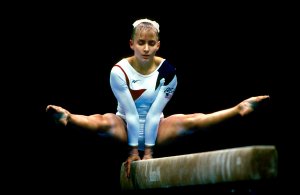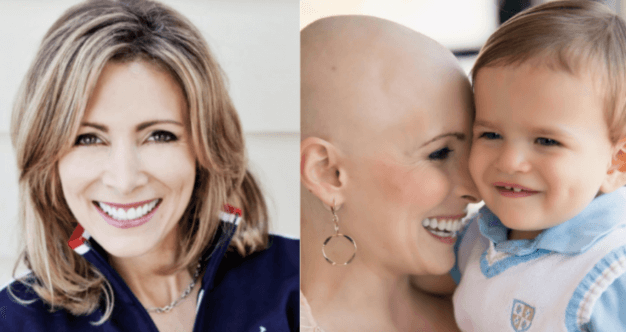Gymnast Shannon Miller, 42, won 7 Olympic medals, beat ovarian cancer, had two children, and now she’s on a mission to make sure women pay attention to their health.
“I came from a shy background. I would hardly speak during my [gymnastics] training. But I realized, you know what, I’ll go around and talk about my ovaries all day long if it really does make even one person think, ‘yep, I’m going to go to the doctor. I’m going to focus on my health.’ Then it is all worth it,” Shannon tells SurvivorNet.
Read More
Lessons from gymnastics and cancer
Miller says that while she may have had injuries and hiccups during her gymnastics careers, those didn’t prepare her as much as the mental and emotional lessons she learned from the sport, “things like goal setting, teamwork and positive attitude, particularly during chemotherapy.”The nausea from her chemotherapy treatments was one of the hardest parts of her journey, and that she often couldn’t believe how weak she felt, “Here I had swung around uneven bars for more than a decade and now I couldn’t open a bottle of water.”

And the primary way she got through it was by setting small goals for herself. As a gymnast, her goals were “to compete to the best of my abilities, to learn my next skill,” she says. But when it came to chemotherapy, “my goal on many days was to get up, get dressed, and walk twice around the dining room table. And if I did that I could check the box and that was a good day. I didn’t always get there, but that was the goal.”
In addition to goal setting, the teamwork became extremely important to Miller during cancer, “I’m not sure I had really utilized that lesson all that much in my regular life outside of sport,” she says. “Once I retired I don’t think I thought about it that much. All of a sudden you look around and you have this incredible medical team. But it’s so much more than that. Friends and family, neighbors willing to pitch in and help out at every turn for the smallest of things and the biggest of things.”

The “team,” she says, extended beyond her friends and family, “[support] came from fan mail and emails, and people who would share their stories of hope with me. That really kept me going.”
Staying active during chemo
Miller said that for her, the nausea during chemotherapy was one of the hardest parts of her journey, and couldn’t keep food down for the first week. She said that taking walks, even for just five minutes and doing yoga helped her a lot “in controlling the nausea and just feeling more human again.”
“Once you lose your hair and your eye lashes and your eye brows and your skin is pale, you don’t feel like yourself. You feel at times like you’ve kind of lost yourself in the mix, your identity and being able to move my body allowed me to feel like myself again. And my goal was not really fitness per se, it was trying to keep my strength up. It was more life sustaining than thinking about fitness as being in shape.”

One day, when Shannon was playing with her son out side, he started to run, and she tried to playfully chase after him. “A couple steps in I collapsed,” she says. “People watching might have thought I tripped and fell, but I knew that my legs simply gave out. And that moment was something I will never forget.”
Immediately, she could see how much her body had changed. “I used to bolt down a runway at the speed of light down to the vault and all of a sudden I couldn’t handle three steps. And all of a sudden it was both fear and clarity, and just being stunned with that realization that I had become that weak.” That’s when she really started to focus on strength and stamina. She said it was the moment she realized she didn’t want to live “at a minimum each day” but wanted to “run and play and be strong.”
Working in wellness and health
Miller was already working in wellness and health when she got the diagnosis, but she says that cancer intensified her passion for understanding what health really means to us as individuals. “There’s just no one who knows our bodies better than we do.” She says that when she went public with her diagnosis, a lot of people asked her if she had any symptoms and she always said she didn’t, but that later on, she realized that she didn’t actually know what the symptoms even were. It was her husband reminded her that she called him from work one day with a terrible stomach ache. To her, this is an example of the way she was used to ignoring signs from her body, rather than listening to them.

As a gymnast, she said, she didn’t have to pay attention to major health risks the way she does now. “I don’t know if I took my health for granted. I’m just not sure I ever really thought about it that much. As a gymnast, everyone else was thinking about it. My coaches obviously were focused on health, so my parents made sure than nutrition was there, and I got plenty of physical activity in the gym, and my parents got me to doctors appointments. I might have been worried about injuries, but I wasn’t worried about things that were truly life threatening.” This was the first time she had to come to terms with anything like cancer, “that’ll humble you real quick,” she said.
Inspiring others to think about health
When Miller first decided to go public with her illness, she immediately got feedback that told her to keep sharing her experience.

(c) Dave Black All Rights Reserved
“[I got] a letter from a lady from Texas,” Miller says. “A mom from Texas with three kids and just wrote that she had watched me and cheered for me at the Olympics, and she shared that she always got her kids to their doctors appointments but she couldn’t remember the last time she went,” she said. “And, I’ll never forget this, she said ‘but if it can happen to you it can happen to me and I’m going to make my appointment.'”
Miller says she still has a hard time saying it and remembering it without completely breaking down in tears.
Is there screening for ovarian cancer?
Despite ovarian cancer's reputation for being a devastating disease, what most people don't realize is that when it's detected early enough, it has a better than 90% cure rate. The problem is, it's not an easy disease to diagnose, especially in its nascent stages, so only 20% of cases are caught early on.
Dr. Beth Karlan, a gynecologic oncologist at UCLA Medical Center on screening for ovarian cancer
Dr. Beth Karlan, a gynecologic oncologist at UCLA Medical Center, says, "In certain high-risk women, who have either inherited a defect in a gene called BRCA1 or 2 or other associated genes with hereditary ovarian cancer, you should undergo an ultrasound of the pelvistrans-vaginal ultrasoundand a CA-125 [blood test], because it's the best we have at the current time."
But these tests are only routinely available for women with the aforementioned family histories of cancer, inherited genetic conditions like Lynch syndrome (which is a kind of colorectal cancer) and/or women presenting with recurring symptoms of the disease.
In fact, according to the American Cancer Society, low-risk women may be better off skipping screening if they aren't experiencing symptoms. “In studies of women at average risk of ovarian cancer, using TVUS [trans-vaginal ultrasound] and CA-125 [blood test] for screening led to more testing and sometimes more surgeries, but did not lower the number of deaths caused by ovarian cancer." And so for that reason, they don't recommend routine testing.
So while there's no widespread screening method currently available, researchers are working hard to find one. As Dr. Karlan says, "finding an early detection method for ovarian cancer is really like the holy grail."
Learn more about SurvivorNet's rigorous medical review process.


